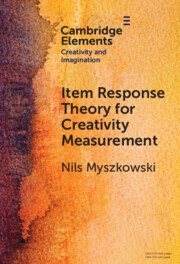Item Response Theory for Creativity Measurement
Published online by Cambridge University Press:
16 February 2024
- Nils Myszkowski
- Affiliation:
Pace University
Summary
Item-response theory (IRT) represents a key advance in measurement theory. Yet, it is largely absent from curricula, textbooks and popular statistical software, and often introduced through a subset of models. This Element, intended for creativity and innovation researchers, researchers-in-training, and anyone interested in how individual creativity might be measured, aims to provide 1) an overview of classical test theory (CTT) and its shortcomings in creativity measurement situations (e.g., fluency scores, consensual assessment technique, etc.); 2) an introduction to IRT and its core concepts, using a broad view of IRT that notably sees CTT models as particular cases of IRT; 3) a practical strategic approach to IRT modeling; 4) example applications of this strategy from creativity research and the associated advantages; and 5) ideas for future work that could advance how IRT could better benefit creativity research, as well as connections with other popular frameworks.

